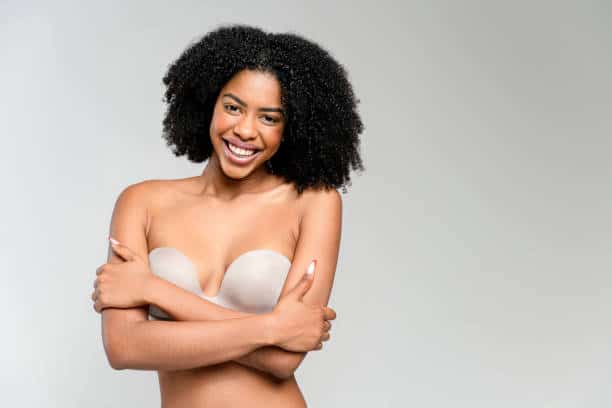The Best Bras for Post Surgery Healing


Whether you’ve just come through a mastectomy, breast reduction, augmentation, top surgery, or any kind of chest procedure — your body deserves comfort and care, not just medically, but emotionally too.
Finding the right bra during recovery isn’t just about support — it’s about helping you heal, both inside and out. And if you’re a Black woman or femme, or someone whose body hasn’t always been centered in standard health advice, this might also feel like new territory.
Let’s take this one step at a time and talk through what kinds of bras really work best post surgery, how to spot the wrong ones, and how to ease back into comfort and confidence on your terms.
RELATED: Breast Cancer Surgery: What Are Your Options?
Why Post-Surgery Bras Matter More Than You Think
After surgery, your chest area is tender, possibly swollen, and is going through some big changes. A well-chosen post-op bra:
- Reduces pain and pressure
- Supports incisions and healing tissues
- Helps minimize swelling
- Prevents complications like fluid buildup
- Makes you feel more secure in your body
And let’s be real: even though bras are often marketed as fashion, after surgery, they’re part of your medical recovery. They need to work with your body — not against it. “Women will need different types of bras to accommodate their anticipated breast sizes and shapes,” says Monique Gary, a board-certified breast surgeon.
RELATED: These 7 Exercises Will Help Ease Your Pain After Breast Cancer Surgery
Key Features to Look For in a Post-Surgery Bra
Not all bras are created equal — especially when you’re healing. The right post-surgical bra should offer a gentle hug, not a squeeze. Here’s what to look for:
Front-Closure Styles
Why it helps: After surgery, it might be hard to lift your arms or reach behind your back. A bra with front hooks, snaps, or zippers lets you dress without strain — which means less pain and less risk of damaging your incision area.
Wire-Free Support
Underwires can press on sensitive areas, irritate scars, or cause discomfort when your body is swollen or adjusting to a new shape. Look for bras with structured support without the metal, especially in the first six to eight weeks.
Soft, Breathable Fabrics
Look for cotton, modal, bamboo, or soft microfiber. These let your skin breathe and reduce the risk of rashes or itching. Moisture-wicking is great, too — especially for warmer climates or if you tend to sweat under your bust.
Wide Bands and Straps
Wide straps distribute weight more evenly and prevent digging into the shoulders — especially important after a reduction or augmentation. A broad underband provides soft compression to minimize swelling and help drain fluids more effectively.
Adjustability
Swelling fluctuates a lot post-surgery. A good bra should be adjustable to accommodate those changes — whether that’s with multiple hook settings, stretch fabrics, or removable pads.
No Internal Seams or Scratchy Tags
Flat seams or seamless construction are ideal. Anything that rubs or irritates healing skin should be avoided. Tagless designs or printed labels are best.
Pockets for Prostheses (Optional)
For those who’ve had a mastectomy and use breast forms, pocketed bras help keep everything in place without slipping or shifting. They also offer the option to wear a form only when you want — on your own terms.
RELATED: 6 Things to Consider Before Getting Breast Reconstruction

A Note for Black Women and Femmes: Your Comfort Matters, Too
So many post-surgical bras come in one shade of “nude,” often don’t reflect our curves, and rarely honor the textures and tones of Black and Brown skin. It can be hard to find bras that fit both our bodies and our healing journeys.
But here’s the truth: you deserve softness, ease, and options — just like anyone else. And you deserve bras that fit your skin, your shape, and your sense of style. Healing is not just physical — it’s emotional. When you feel seen in your recovery gear, you heal better.
Look for:
- Inclusive sizing (cups beyond DD, bands above 40+)
- Skin-tone matching options (browns, caramels, rich shades, not just pale pinks)
- Brands that center on our needs, like:
Matching Bras to Your Surgery Type
Breast Augmentation or Reconstruction
- Go wire-free and soft for the first six to eight weeks (or longer if your surgeon says so).
- Some doctors recommend compression bras to keep implants in place early on.
- Choose something snug but not tight. Think of it like a soft sports bra with benefits.
Breast Reduction or Lift
- Support matters most — you’ll want a bra that reduces bounce and holds you gently.
- Avoid lace or rough seams around incisions.
- Stick with breathable, soft materials that won’t irritate your skin.
Mastectomy (with or without reconstruction)
- Look for bras with soft pockets for prostheses if you’re using them.
- Prioritize high-coverage cups, smooth fabrics, and front closure.
- Some women love mastectomy camisoles for early recovery — no pressure on the chest and super soft.
Top Surgery (Chest Reconstruction)
- You may be in a surgical binder at first — follow your surgeon’s timeline carefully.
- When cleared, switch to a soft, snug-fitting compression bra or sports bra that allows your chest to settle into its new shape.
- Make sure it’s easy to take on/off without lifting your arms too high.

Easing Back into Regular Bras — Gently
Once your incisions are healed and swelling has gone down, you might be tempted to jump right back into your old bras. But give yourself time.
Here’s how to transition safely:
- Wait for your surgeon’s green light. Don’t rush.
- Try your new size before investing in expensive bras. Your size may have changed — especially after a reduction or augmentation.
- Get remeasured at a lingerie store or by a post-mastectomy fitter if possible.
- Ease in with soft-cup bras or bralettes before moving back to underwire or structured bras.
- Check for pressure points. Any pinching, digging, or rubbing means the bra is not ready for your body — or your body isn’t ready for it.
Healing doesn’t have a deadline. Move at your own pace.
Bra Care Tips During Recovery
Taking care of your bras helps them take care of you:
- Buy at least two to three bras to rotate while one is washing
- Use fragrance-free detergent to avoid irritation
- Air dry when possible to maintain elasticity
- Wash every one to two wears during healing to keep things fresh and hygienic
- Store flat or gently folded to avoid warping the shape
You Deserve Care That Feels Good on Your Skin and Your Soul
Let’s be real: healing from any kind of chest or breast surgery is a big deal. Physically, emotionally, even spiritually. And while a bra might seem like a small thing, the right one can do so much. It can:
- Make you feel secure
- Remind you that you’re healing
- Help you see yourself again — not just the scars or swelling
- Let you move through the world with comfort and confidence
You deserve softness. You deserve comfort. You deserve bras that feel like care.




